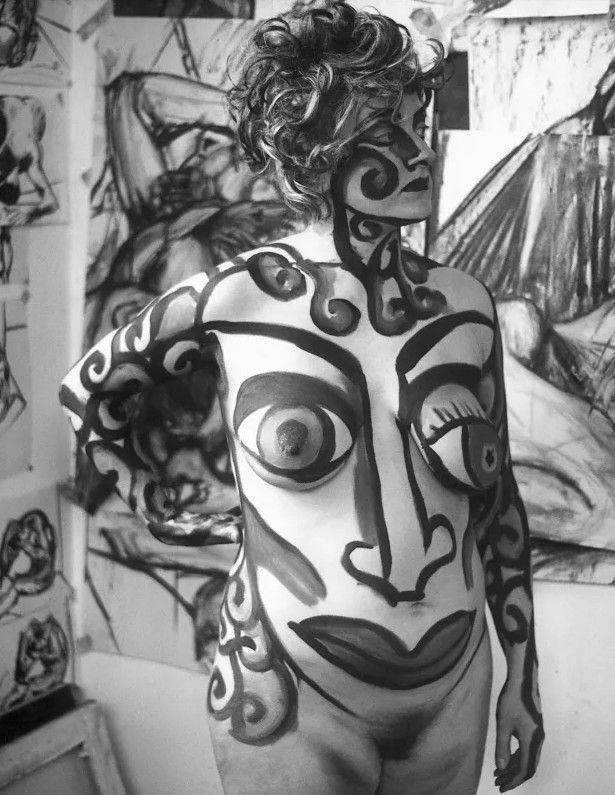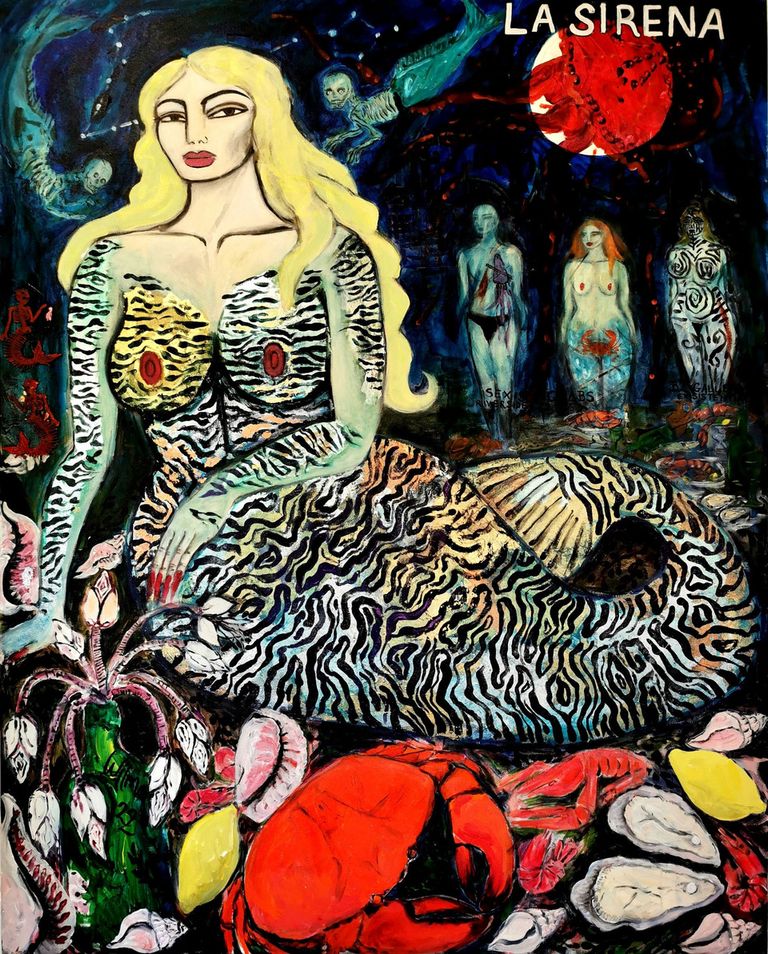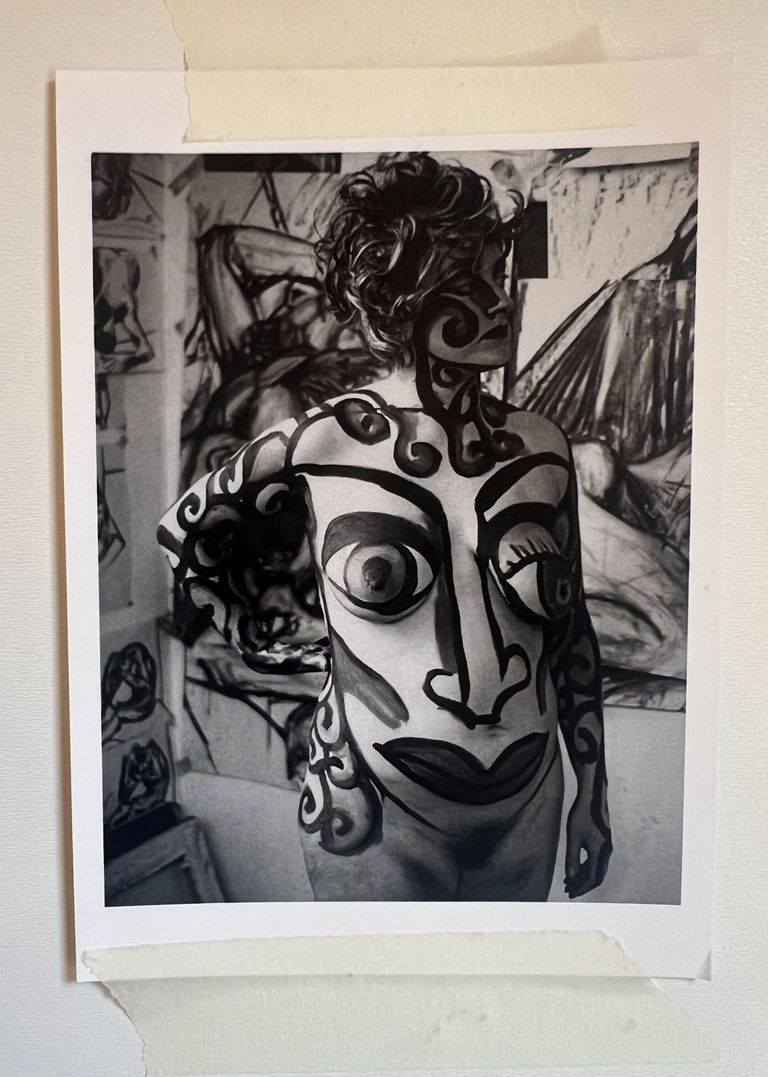
Wilma Johnson and Christine Binnie t St. Martins School of Art 1980.


Wapping Mermaid in the Drowned City of Londinium by Wilma Johnson.

Above Photograph of Postcard purchased at the Towner Gallery in Eastbourne in 2024 by Wilma Johnson. titled "Neo Naturist: Christine Binnie Body-Painted at St. Martin's School of Art in 1980," printed in 2007 and Left Original Image.
Body as a Canvas Interview 2025 with Artist and Activist Wilma Johnson by Alison Dollery.
AD: In 2024, after visiting the Turner Prize exhibition at the Towner Gallery in Eastbourne, I purchased a postcard by Wilma Johnson titled "Neo Naturist: Christine Binnie Body-Painted at St. Martin's School of Art in 1980," printed in 2007. I first became aware of your work at the Press Preview of Tate Britain's Women in Revolt exhibition, part of the Neo Naturists series.
As part of my postgraduate research at the Royal College of Art I am interested in how the body is represented in art practice and utilized as a canvas, specifically using the painted artists body, so I wanted to learn more. Thank you for this interview.
AD: What prompted you to use the body as a canvas in 1980 in the image of Christine Binnie?
WJ: Christine had come to St. Martins as a life model, and I booked her for as a private model. Our idea was to subvert the atmosphere of the life room, which, like the rest of St. Martins at the time was very patriarchal and hierarchical. On the first day she came in I did an action painting of her, then she had to go and buy some body paint for a project she was doing with a fashion student. When I saw the body paint it was like the flashing light bulb moment …. it just seemed like the obvious thing to do was to paint her actual body rather than paint a picture of her body.
My reference points were vague memories of 1960s Summer of Love images and films I’d seen as a child of tribal ritual. I think we somehow fused these in our work from the start, creating our own form of ritual in the performances.
AD: Please tell me more about the context and making of the above postcard and image:
WJ: This was taken in a studio next to mine where the student had hung these very earnest academic drawings form the Life Room , as my work was trying to get away from the sterile atmosphere and what I perceived as objectification of the life models body, it seemed like a perfect backdrop to contrast with the painting I had done on Christine that day. We were heading out to Soho, where I later took the photo of her flashing in front of an erotic book shop. I think these two photos encapsulate two of the things we were reacting against - the objectification of women’s bodies in art, and in the sex industry/ advertising.
AD: Do you use your own body in your work, and if so, please provide a reference or image.
WJ: After a while the dynamic of artist/ canvas/ model was blurred even more when I started joining in with the painting and then eventually performing, so I’m attaching an image form what I think is the first photo session where we both wore paint and used a tripod. I also use my body in my painting a lot, or a version of it. Wapping Mermaid was inspired by a performance we did on the beach in Wapping during our weeklong live-in at the B2 Gallery, and our ’sexist crabs’ cabaret. I’d always been obsessed with mermaids as a symbolic female archetype, and we invented this ‘mermaids’ tail’ effect by painting on scales and sellotaping our legs together. I was going to paint the sellotape, then I thought wait a minute, it’s a painting, I can have a ‘real tail’!
AD: Do you feel women artists using their bodies are/have been underrepresented in the art world?
WJ: Yes, I feel like women artists in general have been overlooked. I also feel very strongly about the fact that women should be allowed to take agency over images of their bodies and use nudity in their work and get very annoyed when my work is censored because it contains nudity. I think the idea that images of the naked female body are somehow intrinsically connected with the patriarchy is getting things completely the wrong way round and taking power away from us rather than empowering or ‘protecting us’.
AD: Your story really resonates with my own motivations for using my body as a canvas in 2019 and I wish I had known about your work sooner. I have noted through my research and highlighted at the Women in Revolt Exhibition at the Tate in 2023 that there is a long history of women artists using their bodies for activism and in their artwork. And your right it’s still somehow intrinsically linked to patriarchal assumptions rather than perceived as empowerment.
I feel the artworld is starting to address this correct the absence of these important works by women in historical texts, and exhibitions for example the recent Carolee Schneeman Exhibition at the Barbican in 2022.
However, I feel 45 years later I am still arguing to use my body in my artwork. Especially as I want it to use it as a way for people to try and experience their bodies differently, as they really are, including the body transforming, my stretch marks, cellulite and lose skin.
Has anything changed since 1980? I still feel I am being censored especially on social media.
AD: Do you have anything further to add on this point?
Has anything changed?
WJ: Very interesting point about whether it’s changed-
I hadn’t done a performance for 30 years when we were invited to do one at the ICA during our Studio Voltaire show. One of the questions I asked myself was whether our work was still needed/ relevant and decided it was. I’d been living abroad for 25 years, and I was really excited by the reaction of younger people to our show and the performance and felt like finally people ‘got us’. It made me feel optimistic about things changing.
The funny thing was that we discussed how we would feel about images of our naked bodies being shared on the internet, then I realised that they were being censored and got really annoyed about it. We’re constantly trying to find ways round it, like putting on ‘emoji bikinis.
AD: That’s very relatable. I went through a similar period of thought and experimentation of trying to understand how to share my work alongside the complexities of sharing images of my body, especially online. Blurring nipples on artworks such as ‘Slab’ to avoid being shadow banned on social media. However public reception has been wholeheartedly positive and a place for much needed bodily relatability in the 21st Century.
Thank you for sharing with me your interview around the Women in Revolt Exhibition and the performance group the Neo Naturists. It is extremely inspiring. Further reading: https://www.cheeriopublishing.com/frame49
Thank you again for your interview.
Artist's Bio
Wilma Johnson is a painter, writer and performance artist. She formed the Neo Naturist performance art group in 1980 appearing at venues including the Royal Opera House. Tate Britain and Globe Theatre in body paint.
Her paintings have been shown in galleries in UK and internationally and were recently included in Women in Revolt! at Tate Britain along with photos and performance documentation.
She was born in London in 1960 and has lived and worked in the UK, Mexico, Ireland and Biarritz, where she wrote the travel memoir Surf Mama, One Woman’s search for love happiness and the perfect wave.
Alison Dollery is a visual artist, writer and researcher on the Materiality of the Body and how the body is used as a canvas/material in art practice. Having exhibited internationally, she holds a BFA (Hons) and MFA in Arts and Humanities from the RCA, having given artists talks at the Royal Academy of Arts and performed at the Tate Modern. From October 2025 she will be studying for her PhD.